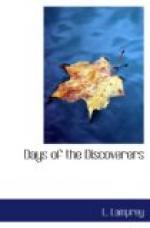Ojeda led an exploring party into the mountains, and found gold nuggets in the beds of the streams. In March a substantial little town had been built, with a church, granary, market-square, and a stone wall around the whole. The Admiral then organized an expedition to explore the interior.
On March 12, 1494, Colon with his chief officers went out of the gate of the settlement, which had been named for the Queen, at the head of four hundred men, many of whom were mounted, and all armed with sword, cross-bow, lance or arquebus. With casques and breastplates shining in the sun, banners flying, pennons fluttering, drums and trumpets sounding, they presented a sight which should have brought ambassadors from any monarch of the Indies who heard of their approach. But although a multitude of savages came from the forest to see, no signs of any such capital as that of the Great Khan appeared. At the end of the first day’s march they camped at the foot of a rocky mountain range with no way over it but a footpath, winding over rocks and through dense tropical jungles. There appeared to be no roads in the country.
But this was not an impossible situation to the young Spanish cavaliers, for in the Moorish wars it had often been necessary to construct a road over the mountains. A number of them at once volunteered for the service, and with laborers and pioneers, to whom they set an example by working as valiantly as they were ready to fight, they made a road for the little army, which was named in their honor El Puerto de los Hidalgos, the Gentlemen’s Pass. When they reached the top of this steep defile and could look down upon the land beyond they saw a vast and magnificent plain, covered with forests of beautiful trees, blossoming meadows and a network of clear lakes and rivers, and dotted here and there with thatch-roofed villages. Near the top of the pass a spring of cool delicious water bubbled out in a glen shaded by palms and one tall and handsome tree of an unknown variety, with wood so hard that it turned the ax of a laborer who tried to cut a chip of it. Colon gave the plain the name of the Vega Real or Royal Plain.
Of all the events, exploits and intrigues of those first years in the Spanish Indies, no one historian among those who accompanied the expedition ever found time to write. Where all was so new, and every man, whether priest, cavalier, soldier, sailor, clerk or artisan, had his own reasons and his own aims in coming to this land of promise, nothing went exactly according to anybody’s plans. The Admiral was soon convinced that in Hispaniola at least no civilized capital existed. To their amazement and amusement the Spaniards found that the savages feared their horses more than their weapons. It was discovered after a while that horse and rider were at first supposed to be one supernatural animal. When the white men dismounted the people fled in horror, believing that the ferocious beasts were going to eat them.




